Israel ... Articles in the News
Photos: The Ancient Ruins of Shivta in Southern Israel Live Science - November 27, 2018
Ancient Shivta in southern Israel was once part of a thriving group of desert cities on a trade route between the Mediterranean coast and the east of Arabia. Shivta was inhabited since before Roman times in the first century B.C., until early Islamic times in the ninth century A.D
Ancient Stone Found at Underwater Site Reveals Historical Information Epoch Times - December 20, 2016
Researchers in Israel have discovered an engraved stone that identifies Gargilius Antiquus as Judea's Roman governor at the time of the Bar Kochba Revolt. Though it is well known that the Bar Kochba revolt, a failed attempt to overthrow Roman rule in the area, occurred in the early half of the 2nd century A.D., there has been less certainty about the identity of the Roman charged with overseeing the area during that period. The name Gargilius Antiquus did come up in a previous research endeavor, but was not linked to a specific place. As a result, there was great debate concerning whether he was a ruler of Syria or Judea.
Immense 1,900-Year-Old Slab Found Underwater Names Forgotten Roman Ruler During Bloody Jewish Revolt Ancient Origins - December 23, 2016
A team of researchers from the University of Haifa have recently discovered a rare inscription from the period prior to the Bar Kochba revolt. The enlightening discovery allows historians to finally identify Gargilius Antiquus as the Roman governor of Judea at that time. This huge stone slab was discovered underwater off the coast of Israel in an area rich with important artifacts. One of the Most Important Moments in Jewish History: The Bar Kokhba Revolt The Bar Kokhba (Kochba) revolt was a rebellion created by the Jews of the Roman province of Judea against the Roman Empire. It took place around 132-136 AD and was the last of three major Jewish-Roman wars. Around that time, the Jewish rebels were hiding in caves in order to be able to perform their mitzvahs. When they were discovered by Roman authorities they usually resisted, but they were not always successful.
4,000-Year-Old 'Thinker' Sculpture Uncovered in Israel Live Science - November 25, 2016
A ceramic vessel bearing the sculpture of a pensive-looking figure has been found in the Israeli city of Yehud. The vessel dates back about 4,000 years, according to the Israel Antiquities Authority (IAA). Archaeologists found the artifact during excavations in advance of a new housing development. Yehud Wikipedia
Cavers find treasure from era of Alexander the Great in Israel CNN - March 10, 2015
Hen Zakai loves exploring darkness. In his spare time, he lowers himself into the underground world of hidden caves to navigate the nooks and crevasses of a very different environment. Zakai was recently spelunking with his father and a friend, all of whom are members of the Israeli Caving Club, when Zakai spotted a shiny silver object in one of the most well-hidden stalactite caves in northern Israel.
Cavers Find Ancient Hoard of Coins and Jewelry in Israel Live Science - March 9, 2015
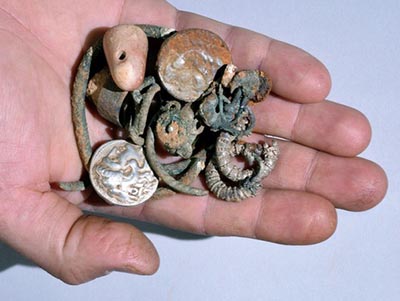
While spelunking in northern Israel, cavers stumbled upon a hidden stash of ancient coins and jewelry from the era of Alexander the Great, the Israel Antiquities Authority (IAA) announced today (March 9). IAA officials suspect locals may have put these artifacts in the cave for safekeeping during a time of political unrest 2,300 years ago - but they wouldn't have been the first. Archaeologists who inspected the cave found even more ancient objects inside, some 6,000 years old. To prepare for an upcoming expedition, three members of the Israeli Caving Club - Reuven Zakai; his 21-year-old son, Hen Zakai; and their friend Lior Halony - were exploring a stalactite cave in northern Israel two weeks ago, according to a statement from the IAA.
Silver Hoop Earrings Found Among Ancient Treasure in Biblical City Live Science - February 21, 2014
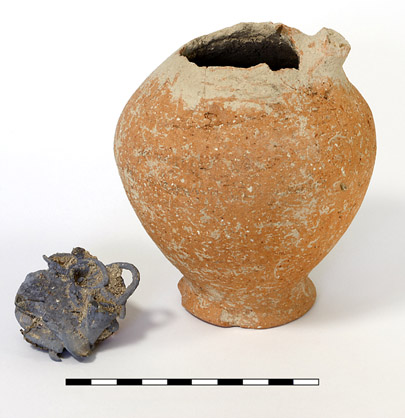
A jug containing silver earrings and ingots has been discovered at the ancient biblical city of Abel Beth Maacah in Israel. Found to the north of a massive structure that may be a tower, the jug and its treasure appear to date back to about 3,200 years ago, long before minted coins were invented, archaeologists said. Curiously, they found no sign that the treasure was hidden, and no one appears to have gone back for it, they added. When the treasure was discovered, the silver was bunched together in what looked like a big ball.
Ancient Rural Town Uncovered in Israel Live Science - February 18, 2014
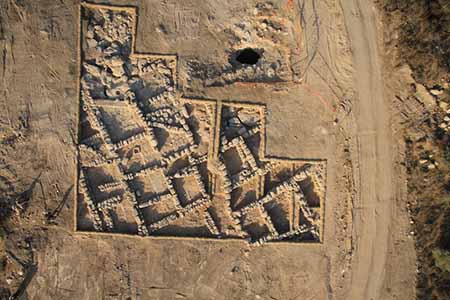
On the outskirts of Jerusalem, archaeologists have discovered the remains of a 2,300-year-old rural village that dates back to the Second Temple period, the Israel Antiquities Authority (IAA) announced. Trenches covering some 8,000 square feet (750 square meters) revealed narrow alleys and a few single-family stone houses, each containing several rooms and an open courtyard. Among the ruins, archaeologists also found dozens of coins, cooking pots, milling tools and jars for storing oil and wine.
Ancient Estate and Garden Fountain Unearthed in Israel Live Science - December 8, 2013
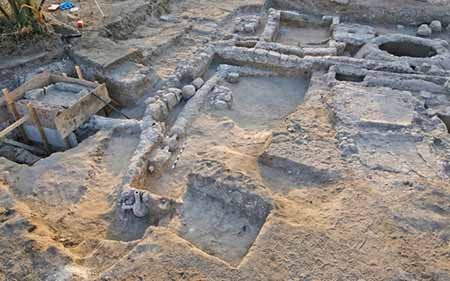
The remains of a wealthy estate, a mosaic fountain and a system of pipes connected to a large cistern dating back to the late 10th and early 11th centuries have been unearthed in Ramla in central Israel, archaeologists report. It seems that a private building belonging to a wealthy family was located there and that the fountain was used for ornamentation.
Photos: Roadside Dig Reveals 10,000-Year-Old House in Israel Live Science - November 25, 2013
Archaeologists have opened up several trenches in Eshtaol along Israel's Highway 38, which is being expanded. There, a crew with the Israel Antiquities Authority has uncovered artifacts spanning thousands of years of ancient history, including the remains of house from the eight millennium B.C.
Oldest Royal Wine Cellar Uncorked in Israel Live Science - November 22, 2013
These 3,700-year-old jars were discovered in an ancient palatial wine cellar unearthed by researchers at Tel Kabri in July 2013. The team worked in day and night shifts to excavate a total of 40 intact vessels during its six-week dig. Archaeologists have uncovered the oldest known palatial wine cellar in the Middle East at a site in Israel. The storage room stocked at least 3,000 bottles' worth of the intoxicating beverage in massive pottery jars. The ancient wine bore little resemblance to the Bordeaux and Chianti of today - it was preserved and spiced with resin and herbs, including juniper, mint and myrtle. The closest modern analogue is a Greek wine flavored with pine resin called retsina.
Ancient Bowl With Hebrew Inscription Discovered in Biblical City Live Science - August 20, 2013
An archaeological dig in the City of David, an ancient site in Jerusalem, uncovered shards of pottery, clay lamps, figurines and a ceramic bowl with a 2,700-year-old inscription in ancient Hebrew, according to new research. A layer of artifacts was found during a recent excavation of an area known as Gihon Spring, which was the main source of water for the City of David. The ceramic bowl, with its partially preserved inscription on the rim, likely dates back to about 600 B.C. to 700 B.C., said lead researcher Joe Uziel, an archaeologist with the Israel Antiquities Authority. The inscription is likely the latter part of the name of an individual from the seventh century B.C., the researchers said. While Uziel and his colleagues are investigating the significance of the ancient inscription - including possible links to the Bib the researchers say the meaning of the engraving is unknown so far.
Evidence of 3,000-Year-Old Cinnamon Trade Found in Israel Live Science - August 20, 2013
How far would you go to get your cinnamon fix? If you lived in the Levant 3,000 years ago (a region that includes modern day Israel), very far indeed new research indicates. Researchers analyzing the contents of 27 flasks from five archaeological sites in Israel that date back around 3,000 years have found that 10 of the flasks contain cinnamaldehyde, the compound that gives cinnamon its flavor, indicating that the spice was stored in these flasks.
Pharaoh's Sphinx Paws Found in Israel Live Science - July 9, 2013
Archaeologists digging in Israel say they have made an unexpected find: the feet of an Egyptian sphinx linked to a pyramid-building pharaoh. The fragment of the statue's front legs was found in Hazor, a UNESCO World Heritage Site just north of the Sea of Galilee. Between the paws is a hieroglyphic inscription with the name of king Menkaure, sometimes called Mycerinus, who ruled Egypt during the Old Kingdom more than 4,000 years ago and built one of the great Giza pyramids. Researchers don't believe Egypt had a relationship with Israel during Menkaure's reign. They think it's more likely that the sphinx was brought to Israel later on, during the second millennium B.C.
Israelis find 2,750-year-old temple
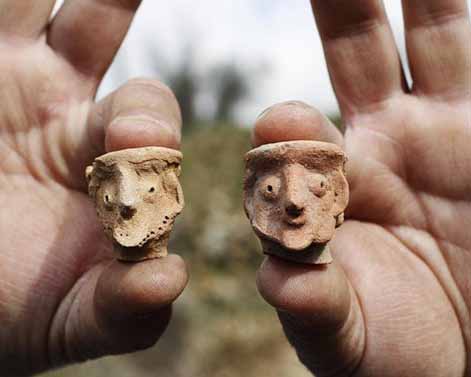
These figurines closely resemble the Anunnaki.
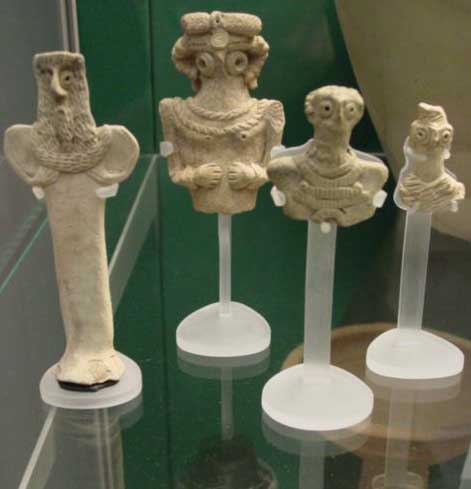
Israelis find 2,750-year-old temple MSNBC - December 27, 2012
Archaeologists have uncovered a 2,750-year-old temple near Jerusalem, along with pottery and clay figurines that suggest the site was the home base for a ritual cult, the Israeli Antiquities Authority said Wednesday. The discovery was made during excavations at the Tel Motza archaeological site, about 3 miles (5 kilometers) west of Jerusalem, during preparations for work on a new section of Israeli's Highway 1, the agency said in a statement.
"The ritual building at Tel Motza is an unusual and striking find, in light of the fact that there are hardly any remains of ritual buildings of the period in Judaea at the time of the First Temple," excavation directors Anna Eirikh, Hamoudi Khalaily and Shua Kisilevitz were quoted as saying in the statement.
The Bible says the First Temple was built in Jerusalem by Solomon, son of King David, and archaeologists estimate that construction was undertaken in the 10th century B.C. The excavation's directors say the Tel Motza temple must have been active in an era "prior to the religious reforms throughout the kingdom at the end of the monarchic period (at the time of Hezekiah and Isaiah), which abolished all ritual sites, concentrating ritual practices solely at the Temple in Jerusalem."
Tel Motza was thought to be associated with the ancient settlement called "Mozah" in the Book of Joshua. During previous work, archaeologists uncovered a large structure with storehouses and a number of silos. They said that structure might have served as a storage facility for Jerusalem's grain supplies.
The newly discovered structure has massive walls and a wide, east-facing entrance, conforming to the tradition of temple construction at the time, the site directors said. "The rays of the sun rising in the east would have illuminated the object placed inside the temple first, symbolizing the divine presence within," they said.
Inside the temple, archaeologists found what appeared to be a square altar, with a cache of ritual items nearby. Those items included fragments of pottery chalices, decorated ritual pedestals and two types of pottery figurines. Some of the figurines represented animals - mainly horses in harnesses - while others were humanlike heads with curling hair and flat headdresses. Such figurines hint at the influence of Philistine coastal culture.
"The find of the sacred structure, together with the accompanying cache of sacred vessels, and especially the significant coastal influence evident in the anthropomorphic figurines, still require extensive research," the directors said.
ISRAEL INDEX
MIDDLE EAST INDEX
ANCIENT CIVILIZATIONS INDEX
ALPHABETICAL INDEX
CRYSTALINKS HOME PAGE
PSYCHIC READING WITH ELLIE
BOOK: THE ALCHEMY OF TIME
DONATION TO CRYSTALINKS
ADVERTISE ON CRYSTALINKS
MIDDLE EAST INDEX
ANCIENT CIVILIZATIONS INDEX
ALPHABETICAL INDEX
CRYSTALINKS HOME PAGE
PSYCHIC READING WITH ELLIE
BOOK: THE ALCHEMY OF TIME
DONATION TO CRYSTALINKS
ADVERTISE ON CRYSTALINKS





